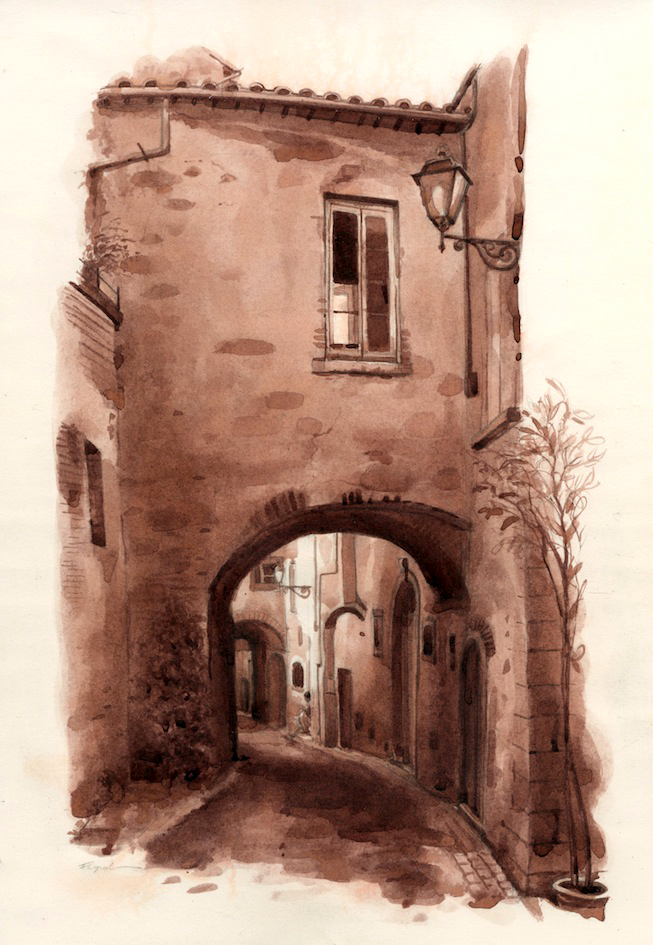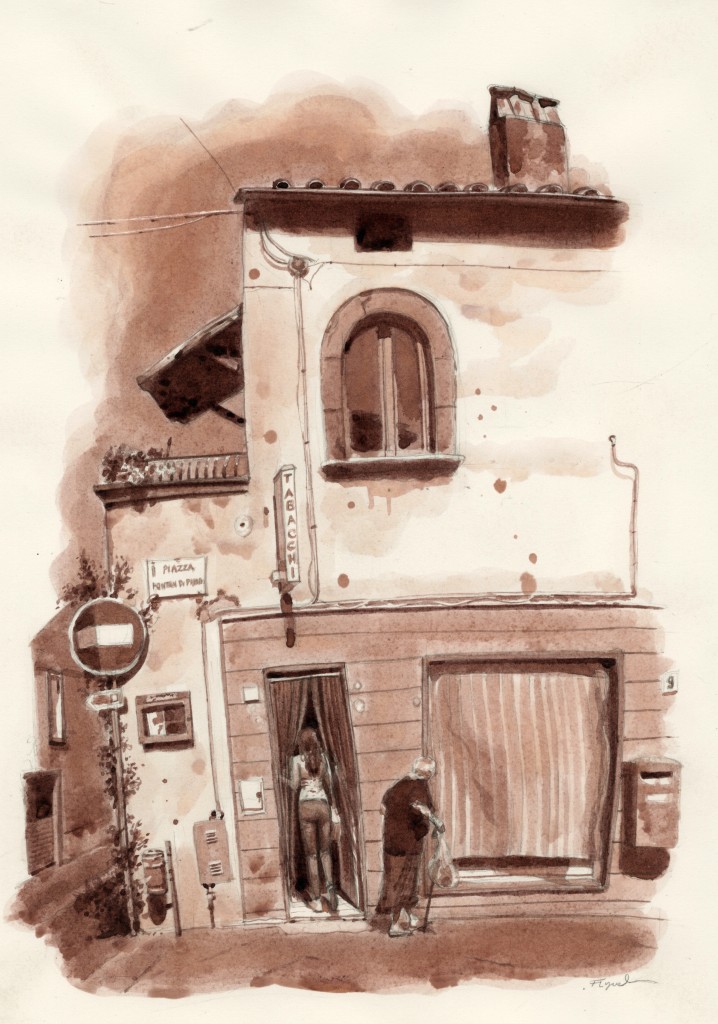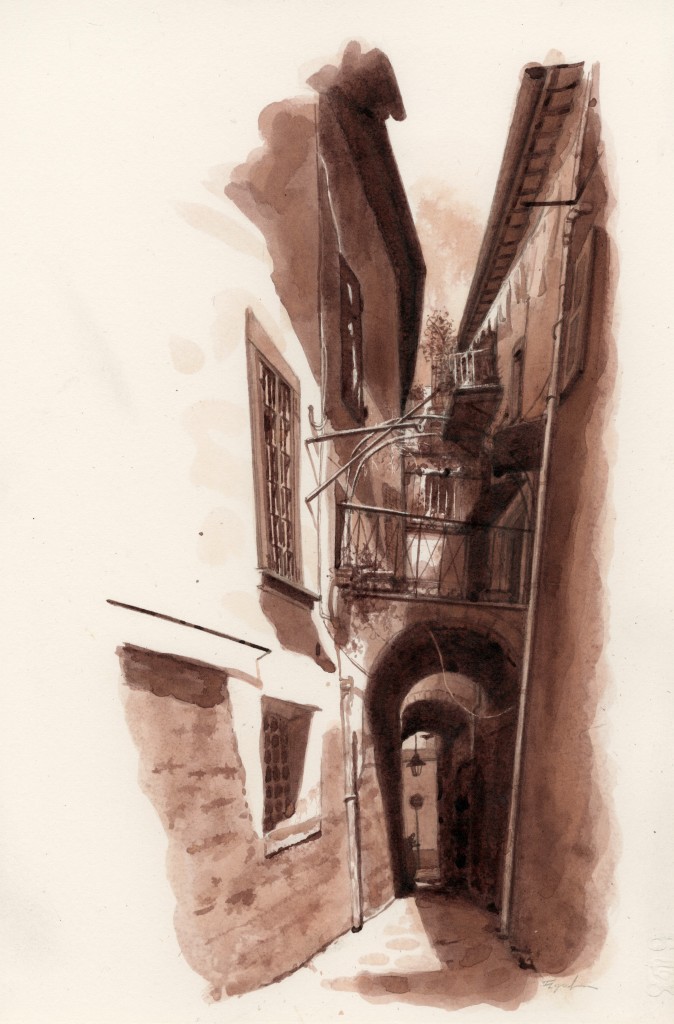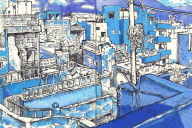Italy is such a diverse country – you’ve got the ancient ruins of Rome, the beaches of Sicily, and the quaint mountain towns that pepper the landscape. It is a country that has intrigued me for a long time (though I’ve only stepped foot in Venice and Trieste) so I loved coming across Fred Lynch’s sketches of lesser-known parts of it.
Your drawings have a lovely soft, subtle style to them. How did this develop?
My drawings look the way they do by result, but not by intent, actually. Style is what you can’t help but do. When an artist develops, they end up making work that is natural to them, an expression of their enthusiasms. And the materials that one ends up using, serves those enthusiasms. In other words, I’m simply trying to create work that matches my interests. I find myself often drawing architecture not as landscape drawings, but as portraits. I’m very focused on the personality of the places and the gesture of forms. My subjects are often simple and direct, unglamorous and unromantic. I try very hard to follow my own instincts and to honestly capture what draws my attention and pleases my senses. More often than not, the drawings feature a strong sense of light and shadow, texture, and a contrast of big forms and little details. I use brown ink both as a tribute to all the great artists who proceeded me on their “Grand Tours” of Italy, and because I’m simply not confident enough in my color use to succeed in a limited amount of time. 
Amelia’ Arch
Let’s talk about process. What steps do you take when creating each piece?
Working on-site is fundamental to me. But, before every drawing comes the wandering. Rarely do I know what I’d like to draw before I find it. It’s not uncommon for me to walk for hours, circling around the narrow streets of Italy, hoping to find a worthy subject—to be at the right place at the right time. I’m seeking serendipity – to be pleasantly surprised and suddenly inspired to sit and capture what’s before me. It’s a kind of hunting. Every sketch starts with a ten-minute gestural, light pencil drawing to interpret the scene, followed by an hour or two of perspiration. I sit on a collapsable stool and have a messenger bag filled with my drawing essentials. I work the entire surface from the general to the specific and from the light to the dark with brown ink. While I strive to capture the scene as I see it (to get it “right”), I’m not at all afraid to impose my personality on the work. I aim to make an original translation of what’s before me, and not a copy. I bring a pocket camera and snap a picture or two while I draw, because you never knows what could interrupt a drawing at a crucial point. Often, trucks park before me and block my view. At home, much later, I look at the photos as an aid to darkening the washes of ink. It takes many layers to get the brown to get as dark as I wish it to be. I flesh out people too, from photos, although I don’t often put them in my drawings. Every time I sit and draw, I wonder if I’ll succeed in the end. It feels like walking a tight rope. Happily, it almost always works out and I usually end up feeling satisfied. That said, I don’t love all my drawings and I wish to push myself further each time I work, which is easier said than done! I’m never comfortable. I’m drawn to the difficult, I guess. 
Neighbourhood Store
What inspires your drawings of Italy?
Traveling gives you a fresh pair of eyes. Away from home, we notice so much more, our senses are awakened. Every July, I teach drawing to college art students in Central Italy, in the small city of Viterbo. The area is filled with fascinating and historic sites. Personally, I love small towns, off the beaten path. The scale of the historic towns, many medieval, is very pleasing to me. Small streets, arches and alleyways which are unchanged for centuries. There is cohesion of all the forms. Everything fits together and exists at a human scale. It’s a walking, not a driving experience. Also, the warm summer light carves up the town in exciting ways.
What do you hope your drawings tell viewers about Italy?
I hope I inspire travelers to look more at the overlooked. Italy is so different from where I come from (the United States), in that there are layers and layers of history before your eyes. And it’s everywhere. On the most insignificant side road, can sit a Roman or Etruscan ruin, with a fascinating untold history behind it. With that comes a fascinating juxtaposition of old and new. The most fashionable characters will emerge from medieval buildings. I urge travelers to get away from the typical and explore. Even in the seldom visited city of Viterbo, I find myself most interested in the outskirts and alleys, which I have found to be very safe and friendly. 
The Quiet Foyer
Where or what was your favourite place or thing to sketch in Italy and why?
To walk through Italy with your sketchbook is to walk in well-worn footsteps of generations traveling artists. Think of all the artists who travelled to Rome: Corot, Goethe, Escher, Fragonard, Claude Lorraine, George Inness, Nicolas Poussin, Frederick Child Hassam, Eugène Delacroix and Thomas Cole, Or, how about Venice? John Singer Sargent, Joseph W. M. Turner, John Ruskin, and William Merritt Chase all created stunning art there. And those are just the tip of the iceberg. The list is endless and as a fellow artist, I find it intimidating. Whether it’s because I’m competitive, or a coward, I’ve never drawn the Colosseum in Rome, despite passing it a number of times. I’m not ready yet to take my turn and exist by comparison to such giants. So, you’ll find me in unexpected places. Often people are surprised by what I’m drawing, when they see me working. It’s not uncommon for old ladies to tell me to not draw where I am, because it is not beautiful. They point to the Cathedral and tell me to draw there. But, the cathedral doesn’t need me. I choose to draw attention elsewhere. 
Viterbo Alley
Do you have any tips for readers who are planning on visiting Italy?
I once read advice about traveling to Rome, that in order to get a more authentic experience of the city, one should walk two blocks down then two blocks over, from the tourist attractions. Well, for me, I’m 60 miles north and 30 miles west from Rome, and it’s fantastic. While Florence, Rome and Venice hold extraordinary treasures, which are well worth seeing, I would urge travelers to experience lesser travelled places which are beautiful and accommodating as well, such as Lucca, Spoleto and Orvieto (all in Central Italy) which I’ve enjoyed immensely.
If you could go anywhere in the world to draw, where would it be and why?
I can’t think of a place that couldn’t be interesting to see or draw. That said, I guess I’d like to get back to Ireland, where my ancestors came from. I’ve been twice before, but it was before I was a sketcher. I regret that. There’s a saying “There’s a difference if we see something with a pencil in our hand or without one.” and I believe firmly in that. It goes for writing, as well as drawing. When we sit and look, and linger and consider, the world reveals far more to us. I wish I knew as much about the Irish as I do about Italians, simply because I carry their genes within me. 
The Little House
Finally, do you have any tips to offer readers who might be interested in sketching whilst they travel?
Don’t think you have to be an artist to enjoy sketching or to benefit from it. It’s the experience of looking, and listening that matters and not creating of great art. All my great memories are from sitting onsite, drawing without headphones. Drawings hold the experience like a time-capsule. As for practical tips, reduce your art supplies to what you like to work with. Keep it simple. Make it easy for you to carry and to work with in a small spot. Get a sketchbook or watercolor block with thick paper which can be removed if you’d like to hang a drawing later. If you make mistakes, keep going. My drawings hide and exhibit many big and little mistakes and accidents. Winston Churchill, who was certainly not an artist, took up painting on-site at age 40. He wrote about it enthusiastically in an essay entitled, “Painting as a Pastime” and it has some great quotes worth sharing.
“…the first quality that is needed is Audacity… We cannot aspire to masterpieces. We may content ourselves with a joy ride in a paintbox. And for this Audacity is the only ticket.” – Winston Churchill
He also wrote that, “The painter wanders and loiters contentedly from place to place, always on the lookout for some brilliant butterfly of a picture which can be caught and set up and carried safely home.” I couldn’t agree more. See more of Fred’s Italy drawings here, take a look at his site here, check out his teaching blog here, and to check out his drawing project, Paul Revere’s Ride Revisited, visit here. 











Beautiful drawings and the whole interview is so peaceful I can’t not like it
Lovely drawings- I really like that you say you draw architecture as a portrait. That’s a really beautiful idea. Interesting interview, thank-you!